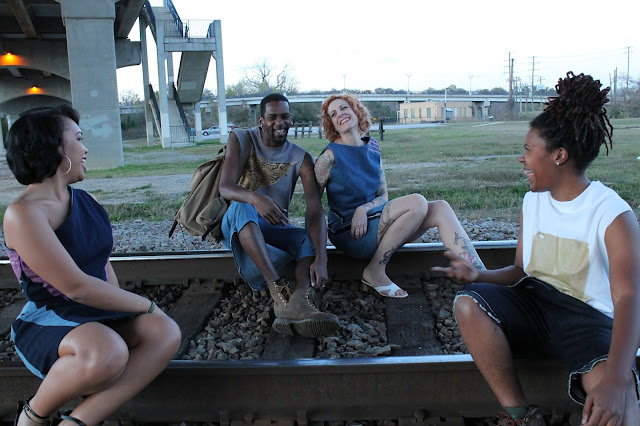Denim. It has been seen in legend sailing the ships of
Columbus and outfitting the American cowboy. This ubiquitous fabric gained
recognition in the United States during the Gold Rush, when it was known as a
fabric of the workers, a low-labor garment that wasn’t seen as suitable outside
of the mines.
Considered to be the most significant event in the first
half of the 19th century, the Gold Rush only lasted a few years
sandwiched between the Louisiana Purchase in 1803 and the Civil War in 1861
when it ushered in an era of opportunity and gain for all who migrated to the west
coast. After the Gold Rush, denim continued as a labor fabric and by the 20th
century evolved into a rebel’s fabric. Fashion Designers turned denim into an
expression of the revolution, changing this working labor fabric into a never-ending
trend.
This body of work traces the rise of denim in American
fashion to the Gold Rush, juxtaposing modern shapes and contemporary fashion
trends as an expression of rebellion with the fabric’s humble origins of a
fabric of honest hard work.
The Denim Rush
The Denim Rush is an expression of rebellion through denim,
using modern lines and shapes that reflect the rise of denim and the Gold Rush.
My aesthetic, which combines function, individuality, and geometric shapes all
combined with an urban edge, dictates the style of my designs. In these pieces,
I combined my personal style with my inspiration of triangular silhouettes seen
during the 1850s, twin sets seen in modern fashion trends, and a mixture of
denim to create the juxtaposition of the Gold Rush with the rise of denim in
American fashion.
All of my pieces share elements such as denim, manipulated
edges, zipper finishing, and patterns that create unity between these singular
items. Each of my women’s tops and skirts are unique but remain cohesive
through a continuation of shapes and similar finishing. My Changshan-inspired
shirts share the same inspiration, representing cultural individuality through
unique designs made cohesive through shape and finish. My men’s pants and
shorts are styled to fit the current trends in menswear that touch on androgyny
and ambiguity through fabric choice and technological advances.
Materials
Denim comes in several weights and washes, and the line’s
women’s pieces are constructed of 11.5–12-ounce denim that maintains the
garments’ feminine lines and shapes. The line’s men’s Changshan-inspired shirts
are constructed of a lighter four-ounce denim for comfort and flexible
wearability. The men’s pants and joggers are constructed in a seven-ounce denim
with ten percent spandex and a snakeskin gold leaf print.
I used a combination or light, medium, and dark wash denim,
zippers as a form of hardware, contrasting fabrics, and manipulated edges
throughout my pieces. During the process of construction I used different
weights of denim being conscious of which weights will hold the shapes I
designed and fit my inspiration for the collection.
Motifs
The finished edges of denim bolts are used as a common motif
between pieces for both men and women. Washes fluctuate between light, medium,
and dark finishes in several weights, the trimming and finishing of which were
decided in the process of construction.
Inspired by immigration during the Gold Rush, cowboys, and
schoolboys, I juxtaposed this iconography against the modern rebel. The Chinese
Changshan-style shirt is inspired by the Chinese miners who were instrumental
in the Snake River Canyon Gold Rush. The men’s pants and shorts are inspired by
cowboys and schoolboys and include additional elements such as spandex and
prints, such as the gold snakeskin pattern that references both the prized
metal of the Gold Rush and the Gold Belt’s Snake River. For the women’s tops,
skirts, and dresses, I used shapes seen in women’s wear during the 1850s, such
as V shaped bodices, and princess seams.
Design and
Construction
Triangles are prominent in these original patterns and are
used to complement the figure. This process requires a sloper, which was copied
and then redesigned to fit each piece. All female pieces were drafted as dress
patterns first and then separated into skirts and tops to ensure matching seams
in the final sets.
For closures, I wanted to replicate the zippers I was using
throughout my pieces. For easier access and wearability, I used separating
zippers in my women’s tops and extended the zippers of the dresses down below
the hip.
The men’s Changshan-inspired shirts were constructed using
the same initial pattern with variation in the wash of the denim and finishing.
The men’s pants and shorts required the same process. A single pattern was
created for the men’s pants and shorts, which was then altered to fit the
concepts for individual pieces. To create some ambiguity, I eliminated the look
of pockets and hid them in the waistband construction. The men’s shorts have
the same hidden pockets and are lined in a gold snakeskin.







